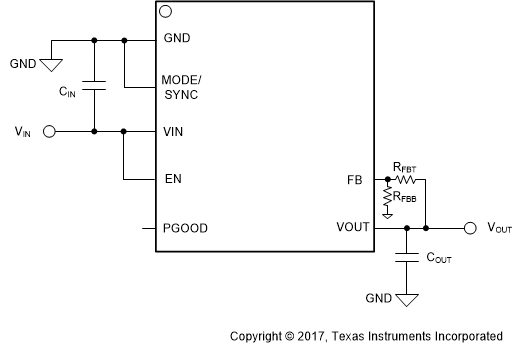ZHCSHO0C February 2018 – March 2023 LMZM23600
PRODUCTION DATA
- 1 特性
- 2 应用
- 3 说明
- 4 Revision History
- 5 Device Comparison
- 6 Pin Configuration and Functions
- 7 Specifications
- 8 Detailed Description
- 9 Application and Implementation
- 10Device and Documentation Support
- 11Mechanical, Packaging, and Orderable Information
9.2.2.4 Feedback Voltage Divider for Adjustable Output Voltage Versions
 Figure 9-4 Adjustable 1.2-V to 15-V Output Typical Application Circuit
Figure 9-4 Adjustable 1.2-V to 15-V Output Typical Application CircuitThe adjustable version of the LMZM23600 regulates the output voltage such that the FB node voltage is equal to the internal VREF voltage of 1 V. The output voltage is then set by a feedback voltage divider formed by two external resistors, RFBT and RFBB.

The range of adjustable output voltage is 1.2 V to 15 V.
Choose a value for RFBT in the kΩ range, and calculate the bottom resistor RFBB using Equation 2:

For VOUT < 3.0 V, TI recommends to allow 20 µA of static load current on the output. This can be achieved by limiting the maximum resistance of the feedback divider. For example, for VOUT = 2 V, the maximum total feedback resistance (RFBB+ RFBT) must be 100 kΩ or less.
For this design example the output voltage is set to 5 V. The fixed 5-V output voltage option of the LMZM23600 can be used without any feedback resistors. If the adjustable output option is used for this design condition, the top feedback resistor RFBT can be set to 102 kΩ. The RFBB value results in 25.5 kΩ.